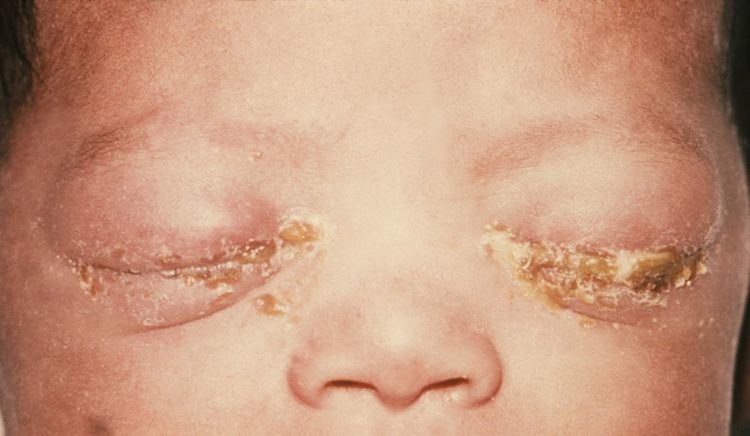Specialty pediatrics ICD-9-CM 098.40, 771.6 MedlinePlus 001606 | ICD-10 A54.3, P39.1 DiseasesDB 9237 eMedicine oph/325 | |
 | ||
Neonatal conjunctivitis, also known as ophthalmia neonatorum, is a form of conjunctivitis and a type of neonatal infection contracted by newborns during delivery. The baby's eyes are contaminated during passage through the birth canal from a mother infected with either Neisseria gonorrhoeae or Chlamydia trachomatis. Antibiotic ointment is typically applied to the newborn's eyes within 1 hour of birth as prevention against gonococcal ophthalmia. Most hospitals in the United States are required by state law to apply eye drops or ointment soon after birth to prevent the disease. If left untreated it can cause blindness.
Contents
Definition
Neonatal conjunctivitis by definition presents during the first month of life. It may be infectious or non infectious. In infectious conjunctivitis, the organism is transmitted from the genital tract of an infected mother during birth or by infected hands.
Epidemiology
The disease incidence varies widely depending on the geographical location. The most extensive epidemiological survey on this subject has been carried out by Dharmasena et al. who analysed the number of neonates who developed neonatal conjunctivitis in England from 2000 to 2011. In addition to the incidence of this sight threatening infection they also investigated the time trends of the disease. According to them the incidence of Neonatal conjunctivitis (Ophthalmia Neonatorum) in England was 257 (95% confidence interval: 245 to 269) per 100,000 in 2011.
Signs and symptoms
Time of onset
Chemical causes: Right after delivery
Neisseria gonorrhoeae: Delivery of the baby until 5 days post-birth (Early onset).
Chlamydia trachomatis: 5 days post-birth to 2 weeks (Late onset—C.trachomatis has longer incubation period)
Complications
Untreated cases may develop corneal ulceration, which may perforate resulting in corneal opacification and Staphyloma formation.
Non infectious
Chemical irritants such as silver nitrate can cause chemical conjunctivitis, usually lasting 2–4 days. Thus, prophylaxis with a 1% silver nitrate solution is no longer in common use. In most countries neomycin and chloramphenicol eye drops are used instead. However, it is possible for newborns to suffer from neonatal conjunctivitis due to reactions with chemicals in these common eye drops. Additionally, a blocked tear duct may be another non-infectious cause of neonatal conjunctivitis.
Infectious
Many different bacteria and viruses can cause conjunctivitis in the neonate. The two most common causes are N. gonorrheae and Chlamydia acquired from the birth canal during delivery.
Ophthalmia neonatorum due to gonococci (Neisseria gonorrhoeae) typically manifests in the first five days post birth and is associated with marked bilateral purulent discharge and local inflammation. In contrast, conjunctivitis secondary to infection with chlamydia (Chlamydia trachomatis) produces conjunctivitis after day three post birth, but may occur up to two weeks after delivery. The discharge is usually more watery in nature (mucopurulent) and less inflamed. Babies infected with chlamydia may develop pneumonitis (chest infection) at a later stage (range 2 weeks – 19 weeks after delivery). Infants with chlamydia pneumonitis should be treated with oral erythromycin for 10–14 days.
Other agents causing ophthalmia neonatorum include Herpes simplex virus (HSV 2), Staphylococcus aureus, Streptococcus haemolyticus, Streptococcus pneumoniae.
Prevention
Antibiotic ointment is typically applied to the newborn's eyes within 1 hour of birth as prevention against gonococcal ophthalmia. This maybe erythromycin, tetracycline, or silver nitrate.
Treatment
Prophylaxis needs antenatal, natal, and post-natal care.
Systemic therapy: Newborns with gonococcal ophthalmia neonatorum should be treated for seven days with one of the following regimens ceftriaxone, cefotaxime, ciprofloxacin, crystalline benzyl penicillin
Research
An upcoming meta-analysis will seek to determine if any type of ophthalmia neonatorum prophylaxis reduces the incidence of conjuncitivitis in neonates and to determine which ophthalmia neonatorum prophylaxis is most effective at reducing the incidence of conjunctivitis in neonates. Eight comparisons to be made in the review include:
- Any versus no prophylaxis
- Erythromycin versus no prophylaxis
- Povidone-iodine versus no prophylaxis
- Tetracycline versus no prophylaxis
- Erythromycin verus Tetracycline
- Povidone-iodine versus Erythromycin
- Povidone-iodine versus Tetracycline
- Povidone-iodine versus Chloramphenicol
